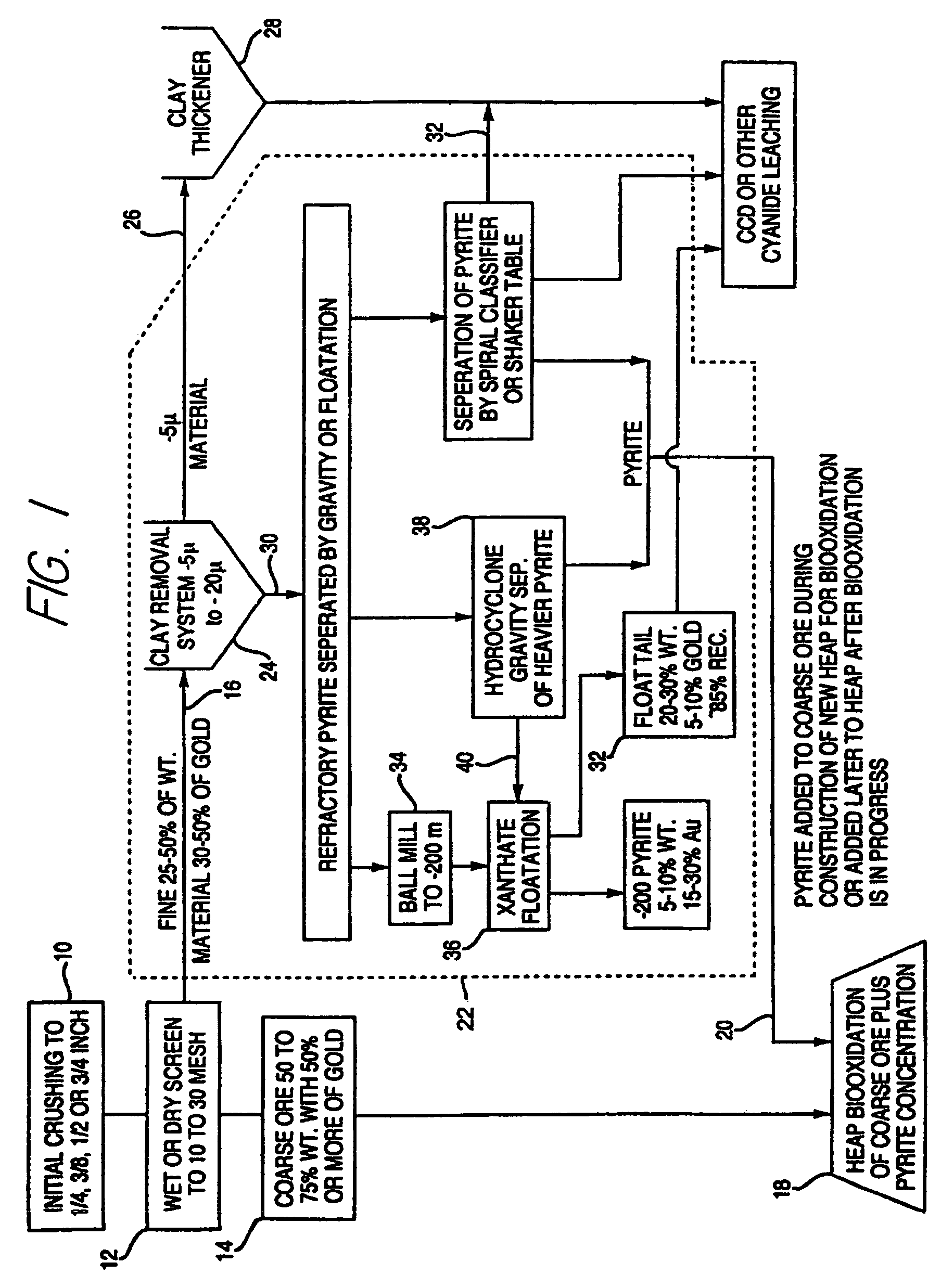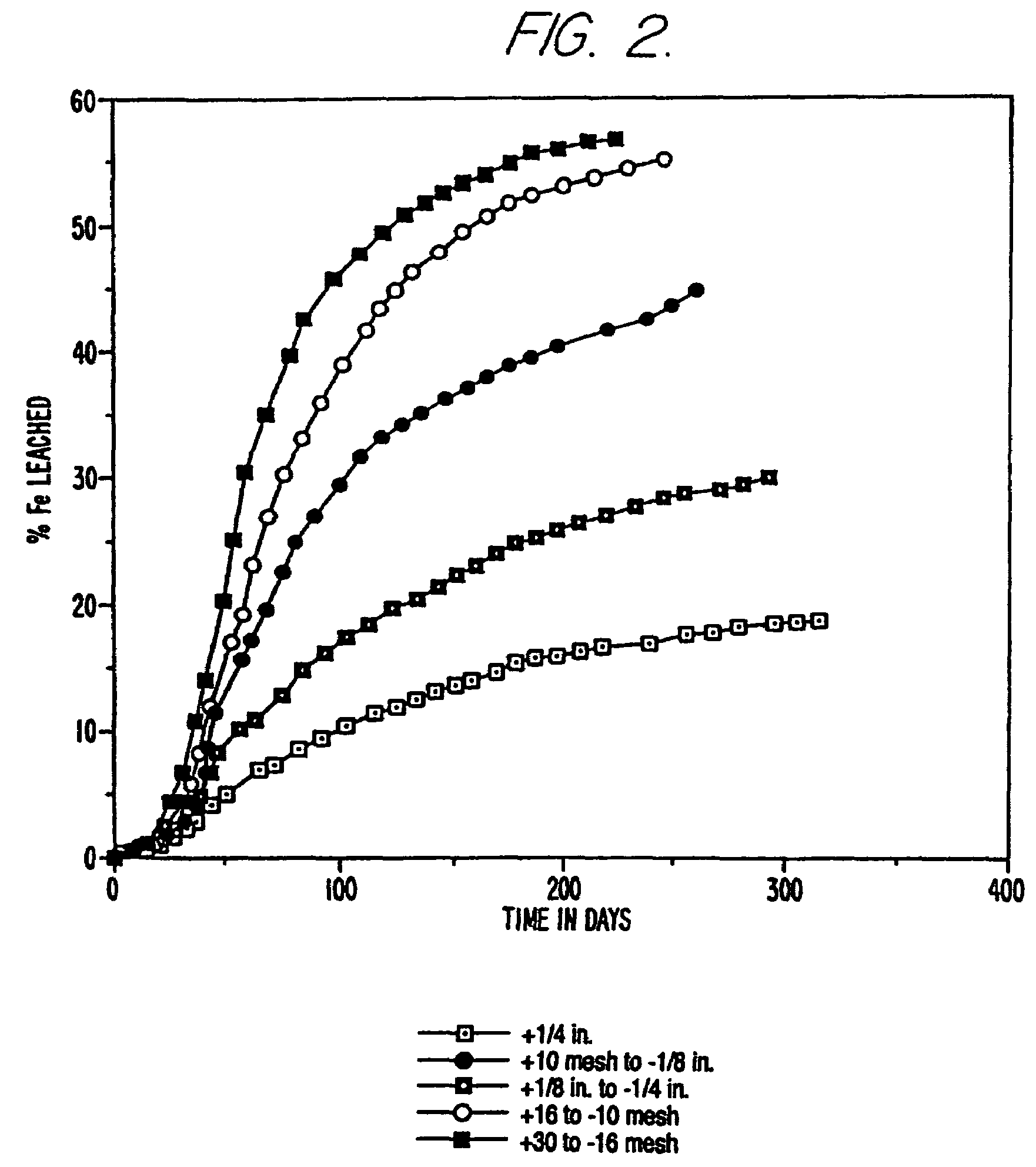Method for recovering metal values from refractory sulfide ore
a technology of refractory sulfide and metal value, which is applied in the field of recovery of metal value from refractory sulfide and refractory carbonaceous sulfide ores, can solve the problems of high ores, inability to conventional cyanidation treatment, and inability to recover materials, so as to improve the recovery of precious metal values and high efficiency
- Summary
- Abstract
- Description
- Claims
- Application Information
AI Technical Summary
Benefits of technology
Problems solved by technology
Method used
Image
Examples
example 1
[0068]A sample of 16 kg of refractory sulfide ore with approximately 0.04 oz / ton of gold and 3.5% of sulfide sulphur was crushed to −¼ inch. The ore sample was then separated by wet screening into a +⅛ to −¼ inch, a +30 mesh to −⅛ inch, and a −30 mesh material fractions. The −30 mesh material was further separated into a pyrite fraction, a sand fraction, and a clay fraction by gravity separation. The sand fraction was further processed by fine grinding in a ball mill for about one hour. This material was then floated with xanthate as a collector.
[0069]Each fraction was then dried and weighed and analyzed for gold. The +⅛ to −¼ inch material represented 51% of the weight and 18% of the gold at 0.48 ppm Au. The +30 mesh to −⅛ inch material represented 28% of the weight and 32% of the gold at 1.47 ppm Au. The total pyrite, which included both the gravity separated pyrite and the pyrite concentrate from the flotation of the sand, represented 4.7% of the weight and 35% of the gold at 9.8...
example 2
[0071]A second sample of ore from the same mine as in Example 1 was crushed to −⅜ inches. Four 23 Kg splits of this sample were combined and wet screened into a +¼ inch, a +⅛ to −¼ inch, a +10 mesh to −⅛ inch, a +16 mesh to −10 mesh, a +30 to −16 mesh, a +60 to −30 mesh, and a −60 mesh fraction. The +60 to −30 mesh and the −60 mesh fraction were used to evaluate a number of gravity separations to make a pyrite fraction a sand fraction and a clay fraction. The dry weights of each size fraction were used to calculate the weight percentage of the size fraction. Each size fraction was also analyzed for the amount of gold, iron and gold extraction by traditional cyanide leaching (see Table 1).
[0072]The five size fractions larger than 30 mesh were put into individual columns for biooxidation. Bacteria and nutrients were added as in Example 1 and air was blown in from the bottom or top of the column. The progress of the biooxidation was monitored by measuring the amount of iron leached fro...
example 3
[0101]Two simultaneous bioleaching tests were set up to test the rate of biooxidation of a gold bearing ore pyrite concentrate. The first test consisted of a column type experiment to simulate a heap leaching process and the second consisted of a shake flask experiment to simulate a stirred tank process.
[0102]The starting concentrate for both tests was obtained from the Jamestown mine in Tuolumne County, California. The mine is owned by Sonora Gold corporation and lies along the mother lode vein system. The concentrate was produced using a xanthate flotation process and contained 39.8% sulfides and 36.6% iron. The sulfide minerals within the concentrate primarily consisted of pyrite. Size analysis showed that over 76% of the concentrate particles were smaller than 200 mesh. The concentrate had a high gold concentration (about 2 oz. per ton of concentrate) and was known to be refractory to cyanide leaching.
[0103]The percentage of biooxidation in each of the tests was determined by an...
PUM
| Property | Measurement | Unit |
|---|---|---|
| particle size | aaaaa | aaaaa |
| pH | aaaaa | aaaaa |
| pH | aaaaa | aaaaa |
Abstract
Description
Claims
Application Information
 Login to View More
Login to View More - R&D
- Intellectual Property
- Life Sciences
- Materials
- Tech Scout
- Unparalleled Data Quality
- Higher Quality Content
- 60% Fewer Hallucinations
Browse by: Latest US Patents, China's latest patents, Technical Efficacy Thesaurus, Application Domain, Technology Topic, Popular Technical Reports.
© 2025 PatSnap. All rights reserved.Legal|Privacy policy|Modern Slavery Act Transparency Statement|Sitemap|About US| Contact US: help@patsnap.com



